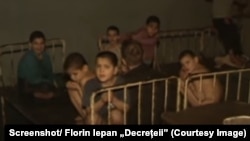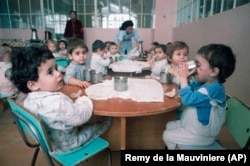BUCHAREST -- The fall of communism in Romania decades ago lifted the lid on the country's infamous network of orphanages, shocking the world with images of dirty and underfed children, most dressed in rags, crammed in filthy wards, some of them chained to beds.
A special Romanian committee established to investigate the crimes of the era of dictator Nicolae Ceausescu, who ruled from 1965 to 1989, has determined that more than 15,000 minors -- orphans, children with physical or mental disabilities, or those unwanted by their parents -- died in orphanages and other residential facilities.
According to the committee, formally known as the Institute For The Investigation Of Crimes Of Communism And The Memory Of The Romanian Exile (IICCMER), many of the deaths were brought on by neglect, including starvation, even though they were not known to have had serious illnesses when they were admitted.
Examining documents linked to the investigations, RFE/RL's Romanian Service has uncovered fresh details about how some children ended up state care homes or orphanages. In many cases, it appears that children were singled out to help finance the residential facility, with state authorities requesting that parents pay for their children's "treatment," according to historian Cosmin Popa.
In October 2022, the IICCMER concluded that more than 15,000 minors died at the 26 facilities across communist-era Romania for disabled and mentally ill children between 1967 and 1990, when the institutions were shut down. According to the IICCMER report, among the reasons for the thousands of deaths were starvation, improper living conditions, abuse, and a lack of medical care.
"Because there was a veritable cult of cutting back on unproductive spending, and these children, by being labeled as irredeemable, meant that they required long-term assistance throughout their lives, and consequently they could never be a useful member of socialist society," Popa said.
The IICCMER said the highest number of deaths was recorded at the notorious Cighid facility, located in Ghiorac close to the border with Hungary, where it determined that 138 children had died between October 1987 and April 1990. During that time, only 183 children had been admitted, the institute noted.
More than 300,000 children were placed in Romania's network of orphanages, children's hospitals, and other facilities for youth between 1954-1989. They became known as "Ceausescu's children" after the Stalinist leader who ruled one of Eastern Europe's most repressive regimes until it came crashing down in 1989 along with most of the Eastern-bloc countries in the region.
During his more than two decades in power, Ceausescu instituted one of the world's most radical and repressive policies to stimulate birth rates, including outlawing abortion for women under 40 with fewer than four children. While the measures triggered a baby boom, many of the children, who were often born to impoverished parents, ended up in state-run orphanages and other facilities. After the fall of communism, the horrific conditions in these institutions were exposed and images of skeletal children living in squalor were broadcast around the world.
Despite work by the IICCMER to uncover the true number of victims who suffered the ultimate fate at these institutions, no one has been held accountable, although the ICCMER has filed multiple complaints with Romanian prosecutors against individuals. Despite that, no one linked to these institutions has ever been tried, let alone found guilty, for the deaths.
RFE/RL's Romanian Service examined documents relating to the Cighid children's home, which operated for just 30 months between 1987 and 1989. The residential home was set up because the facilities in the region treating sick children were already full. Documents show that, of the 138 children who died there, 84 were 3 years old -- the minimum age when they could legally be taken from their families. The most common reported cause of death was bronchopneumonia, a type of pneumonia that affects the bronchi in the lungs.
"Think of a family from the elite of communist Romania, where one child is bright, studies well, and the other is a little less gifted. Many of them -- because you will also find children from perfectly normal families in the records of these institutions -- [have become] artists…teachers…generals. They [were also in] such institutions," Popa said.
An examination of the documents by RFE/RL's Romanian Service found that it was common for such institutions to demand payment from the families of children placed there. "Of course, this sounds ridiculous, but then there were thousands of schools, thousands of orphanages, that were left without funding and that would have simply had to sell the labor of institutionalized people," explained Popa.
Rarely, if ever, was the welfare, let alone the health, of the child weighed when the authorities decided who was sent to one of the notorious facilities, Popa noted. Children from poorer families, many with relatively mild physical or mental health issues, were sent there, Pope said. Even the children of relatively well-off Romanians were often not spared.
Overall, the historian noted, Romania's communist authorities were largely guided by a desire to "exterminate distinct social categories."












